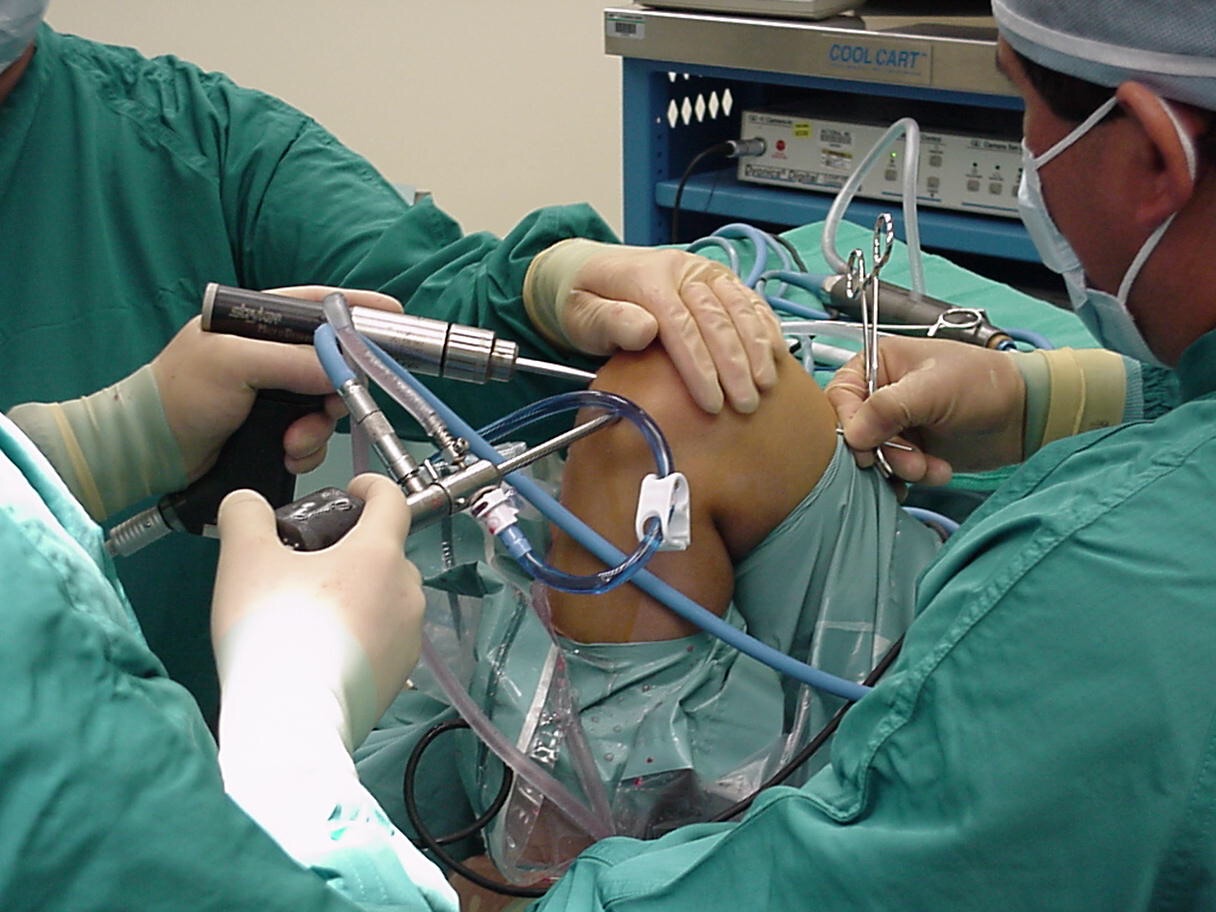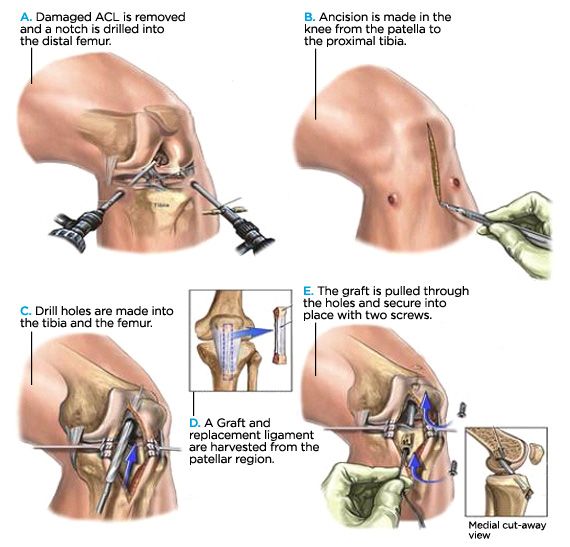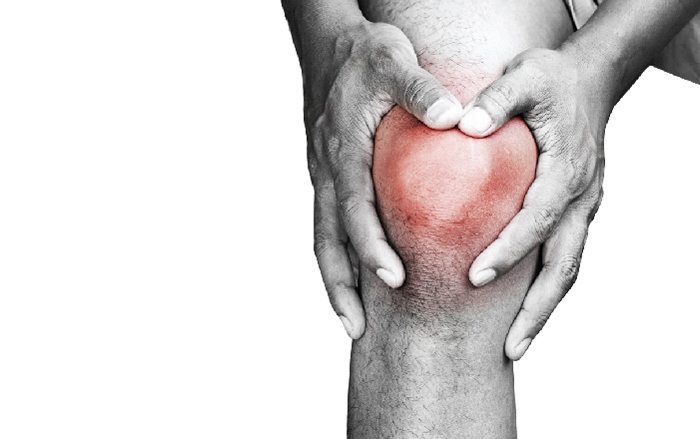The knee joint is one of the most important weight-bearing joints of the body. A number of ligaments are responsible for its stability. One of them is the anterior cruciate ligament (ACL). This ligament is located anteriorly behind patellar ligament. It joins the femur (thigh bone) with the tibia (shin bone). It is so named because it is placed diagonally. It is responsible for forward movement and rotation of tibia over the femur. ACL is among the most commonly damaged ligaments due to falls, accidents, automobile injuries, etc. It may also get injured during sports such as football, basketball, etc. These sports can be the cause of a tear of Ligament fibers, which can be especially painful and impairing of the joint movement. Surgical treatment is available for knee ligament injury.
The Procedure
Contents
The knee ligament surgery begins with anesthetizing the patient. An arthroscope is inserted through a small incision which is used to view inside the joint, this allows the surgeon to clearly see the torn ligament. After this, many smaller incisions are given on and around the joint through which various surgical instruments are inserted into the joint cavity. The anterior cruciate ligament cannot be repaired by sewing its torn fibers together. Its fibers are removed and new tissue is grafted at its place which is taken either from the patellar tendon or hamstring tendons. Alternatively, a cadaver can be used to provide the new fibers – this option is particularly popular among athletes who do not want to lose any speed after recovery. The new ligament is fixed at the same place where the previous ligament was located with the help of staples or screws. After the surgery, your incisions are stitched and bandages are applied over them.

Length of Stay in Destination
The surgery is usually 1 to 1.5 hour long. An overnight stay at the hospital is required after which you are discharged. After being discharged from the hospital, visit your doctor regularly. If you are given dissolvable stitches, they will disappear after 3 weeks. If not, you would have to visit your doctor to get them removed. You will have to stay in the area for 1-2 weeks after surgery for check-ups. You can go home when allowed by your doctor and continue your follow-ups with your local doctor.
Recovery Time
A full recovery can take between 6-9 months, during which time, no contact sport should be played. It can extend to a year depending upon various factors. You can return to work 2 to 3 weeks after the surgery if it is office work. If not, wait for the recovery. At least 3 months are required to get back to it if you do physical work. You can continue to drive 3 to 4 weeks after being operated upon. In 6 months, you can start taking part in sports. 1 year is needed for full-term recovery. You might have swelling in your knee and shin due to the leakage of blood and synovial fluid from the operated joint. Pain killers are given to help you avoid severe pain in the initial days. Swelling and pain are temporary symptoms which subside usually after a week. If not, consult your doctor immediately.
The most important aspect of recovering from ACL surgery is the physiotherapy, this begins immediately after the surgery, usually the next day whilst still in the hospital. Then when you return home, you’ll be expected to do various stretches and exercises 3 times a day, every day for the next 6+ weeks. Regular physio appointments should be attended so the professionals can keep tabs on your recovery. Physio is only finished once you pass a strength test to confirm the joint is now at least 95% of the strength of your good knee. Continued gym work should be adhered to even after clearing the assessment, building the strength of the depleted hamstring is highly advisable.
Success Rate
Anterior cruciate ligament surgery is considered one of the most successful surgeries in Orthopaedics. 85 to 90% success rate is reported for this surgery. After the surgery, the patient is again able to walk and run on his own feet. It is almost always successful. In case it does not work out, the reason can be infection and blood clot formation. The patient feels stiffness in his joint and decreased mobility. In this case, another surgery is required. Revision of this surgery is a complex procedure which might not always be successful. It works to restore your normal mobility. You might not be able to be a part of sports and athletics again. Avoid infections and blood clot formation during the surgery. It is essential to begin physio immediately and to keep this up during the entire recovery period.

Aftercare
Keep the following points in your mind after being discharged:
- Visit your doctor/physiotherapist on a regular basis until you recover completely.
- Take your medicines as and when prescribed by the doctor.
- Ensure the presence of someone with you to look after you. You would need someone to walk you around and to cook for you.
- Keep your knee above your feet by putting pillows below it.
- Eat healthy and nutritious food.
- Ice packs are found to be very effective in reducing swelling. Tie them around your knee.
- Use crutches or other walking aids until your recovery.
- Avoid climbing up the stairs.
- Do not take a shower for some days. Your bandage should not get wet because it can cause infection.
- Avoid exercises and heavy activities in the early few days.
- Start your physiotherapy after the removal of stitches. All exercises should be done under the supervision of an expert.
Alternatives to Knee Ligament Surgery Procedure
Surgery should never be the first option when other treatment methods can help. Following are some effective alternatives to knee ligament surgery:
- Stem cell therapy: stem cells taken from different areas of the body are injected into the knee joint. These cells divide and produce a number of new cells repairing the torn ligament. This significantly reduces pain and inflammation and promotes joint movement.
- Prolotherapy: in this method, an irritant such as dextrose is injected into the joint. It stimulates growth in the damaged ligament causing its regeneration and suppressing the need for surgery. It decreases pain in the joint and helps with mobility.
- Platelet Rich Plasma (PRP): it involves the removal of growth factors from your platelets. Your own blood is taken which is centrifuged to separate platelets from it. After this, growth factors released from platelets are collected and injected into the joint. These growth factors help in regeneration of torn fibers of ACL soothing pain in the joint.
Before and After Knee Ligament Surgery
Before surgery, you experience severe pain and inflammation due to the injured ligament. Your mobility is decreased. You feel stiffness in the joint. Movement initiates pain and swelling. However, after surgery, all of these symptoms are relieved with time. Pain and swelling subside and your normal mobility is restored. You may return to your normal physical activities 6-9 months to a year after surgery.
For an in-depth analysis of Knee Ligament Surgery (ACL), watch this short video.
To check prices or to book a Knee Ligament Surgery (ACL) in Thailand or anywhere else in the world, head on over to MyMediTravel now!

